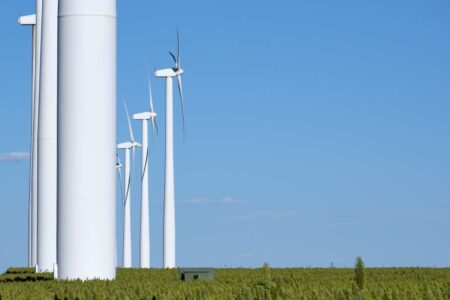Attorney blasts decision on turbine setbacks, saying it amounts to a ‘ban’ on wind energy if Douglas County approves it

photo by: Brian Grimmett/Kansas News Service
Turbines at the Gray County Wind Farm near Montezuma, Kansas.
An attorney for a renewable energy company says plans for a large wind farm in southwest Douglas County will never advance if the Douglas County Commission approves a recent Lawrence-Douglas County Planning Commission decision that significantly lengthened the distance between wind turbines and property lines.
“If that’s the final regulation, no one will ever do a wind project in Douglas County,” Alan Claus Anderson, a Kansas City-based attorney representing NextEra Energy Inc., told the Journal-World Wednesday.
The Planning Commission last week approved a rule that so-called setback distances from non-participating property owners be 2,500 feet, instead of 1,500 feet, from an owner’s property line. Non-participating property owners are those who do not have an agreement with a wind energy company. The ultimate decision on how far wind turbines must be from properties will be up to the County Commission.
NextEra has not filed a permit application to develop a wind farm, but Anderson said the proposed change for setback distances would “drastically increase” the project’s overall regulatory footprint and that it’s “too radical” for NextEra to even entertain.
Anderson told the Journal-World that any plans for a wind farm would “depend significantly on the (final) outcome of wind regulations.”
Anderson said that he has played a role in the development of every major wind farm in Kansas and that “there’s never been one built with those kinds of setbacks, and there won’t be one built. So this is a ban on wind farms in Douglas County.”

photo by: Matt Resnick/Journal-World
Alan Claus Anderson, a Kansas City-based attorney representing NextEra Energy Inc., answers a question from Douglas County commissioners on Wednesday, Jan. 24, 2024.
Anderson had expressed this view in a letter to the Planning Commission earlier this month before the Planning Commission voted 6-3 to make the setback 2,500 feet. One of the three who voted against the rule, Gary Rexroad, voiced the concern last year that a setback distance of that length would likely be “prohibitive” for any future development.
The 2,500-foot setback, according to Anderson, pertains to “every single thing,” including “roads, waterways, cemeteries, property lines, and any occupied structure — not just homes.”
“This just makes it impossible,” he said. “There is no place you can put a turbine at that setback distance, so we’ve ended up with a set of ordinances that no one will build on.”
One draft proposal had the minimum setback distance set at 1,500 feet from a non-participating landowner’s property line, but several planning commissioners raised safety concerns of neighboring residents as a reason to lengthen that distance.
Anderson said the safety concerns were not realistic and that the setback decision, if approved by the county, would send a message that the county is not really interested in fighting global warming.
“It’s a pretty poor message,” he said. “And at some point here in Douglas County, we do have to decide if we care about climate change mitigation. Because the only way we can do that is with large-scale renewable energy.”
“If you look at what the public wants, it’s renewable energy,” he added. “So it was pretty stunning that we could get six votes that went in the other direction.”
Some planning commissioners at their meeting referenced documented incidents in which turbine blades threw debris distances that exceeded 1,700 feet, and cited an incident in Marshall County where fragments from a damaged blade were blown as far as 2,100 feet from the tower structure.
But other planning commissioners said safety issues could be addressed by other means than by lengthy setbacks to protect against every possible mishap, as the Journal-World reported.
“There were those who used science to look at the setbacks, and there were those who chose not to,” Anderson said of the Planning Commission. “Governments have to take action to make it happen. And we, in Douglas County, are saying we don’t want renewable energy. The UN Secretary General (António Guterres) said it’s criminal how our governments are taking no action, and this is kind of an example of what he’s seen. The decision made Tuesday night has no benefits for the residents of Douglas County.”
In his Jan. 5 letter to the Planning Commission, Anderson cited a wind farm in Boone County, Missouri, in which a 1,750-foot setback was imposed, greatly reducing the number of sites where the project could be located.
“To date, no project has been built in Boone County,” the letter said. “Such is the impact of excessive setback distances.”
Anderson’s letter said the same future awaited Kansas if setback distances of 1,500 feet, let alone 2,500, were ultimately required.
“In Kansas, no projects have been built in counties with setbacks of 1,500 (feet) from a property line,” the letter said. “If Douglas County were to impose a 1,500-foot setback, (it) would suffer a similar fate.”
The County Commission has not set a date for when it will consider the matter. As the Journal-World has reported, previous public meetings on the topic have generated considerable public comment.







